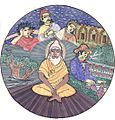Reincarnation research facts for kids
Dr. Ian Stevenson was a scientist from the University of Virginia who studied children. These children often said they remembered a "past life." He talked to over 2,500 children for more than 40 years. He also wrote many books about his research, like Twenty Cases Suggestive of Reincarnation.
Dr. Stevenson looked into how these memories might be connected to reincarnation. Reincarnation is the idea that a person's soul or spirit can be reborn into a new body after they die.
Contents
How Dr. Stevenson Studied Memories
Dr. Stevenson noticed that children's memories of a past life usually appeared when they were between three and seven years old. He would carefully compare what the children remembered with facts about people who had died. He tried to do this before the child or their family had any contact with the family of the person who had died. This helped make sure the child's memories were not just things they had heard or learned.
Birthmarks and Past Lives
About 35 out of every 100 children Dr. Stevenson studied had birthmarks or birth defects. He thought that if a child had a birthmark or a problem with their body in the same place where a person who died had a serious injury, it could be a clue. For example, if someone died from a gunshot wound to the head, and a child later had a birthmark on their head in the same spot, Dr. Stevenson found this interesting.
However, Dr. Stevenson never said he had proven that reincarnation is real. He was very careful and called his cases "of the reincarnation type" or "suggestive of reincarnation." This means they hinted at reincarnation but weren't definite proof.
Continuing the Research
Dr. Stevenson stopped working in 2002. Another scientist, Dr. Jim B. Tucker, took over his research. Dr. Tucker also wrote a book called Life Before Life: A Scientific Investigation of Children’s Memories of Previous Lives. He continues to study children's memories that might suggest a past life.
Related pages
Images for kids
-
Tomb of Allan Kardec, who started a belief system called spiritism. The words on the tomb say: "To be born, die, again be reborn, and so progress unceasingly, such is the law."
-
The 14th Dalai Lama believes it would be hard for science to prove reincarnation is not real.
-
American psychologist and philosopher William James (1842–1910) was an early researcher of unusual mental abilities.
-
Hindus believe the soul (atman) is reborn many times until it reaches a state of freedom called moksha.







